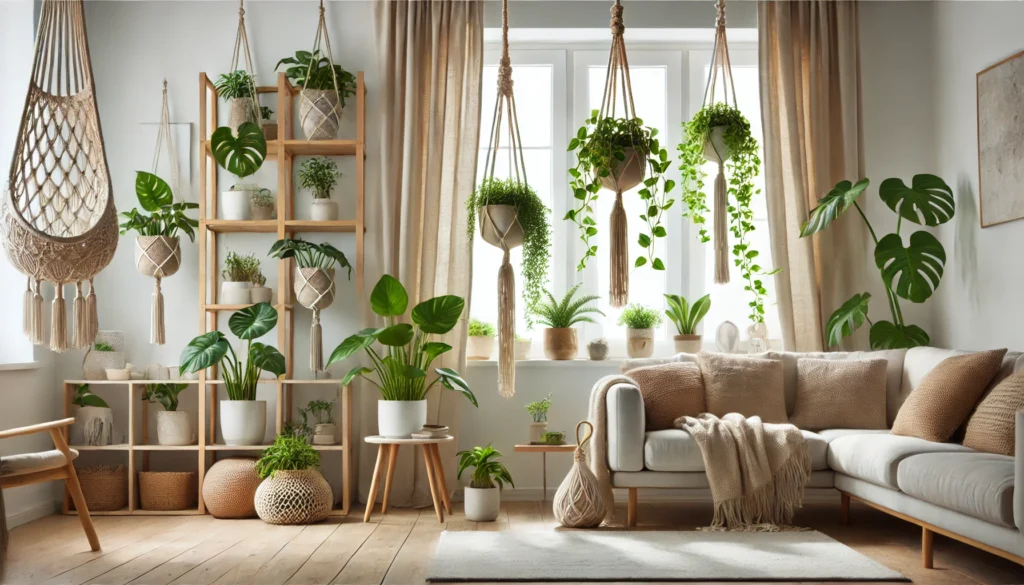
Using Macramé Hangers for Houseplants: A Stylish and Practical Way to Display Your Greenery
Are you looking for a stylish way to display your houseplants while saving space and adding character to your home? Using macramé hangers for houseplants might just be the solution you need. This charming and versatile trend brings a boho-inspired aesthetic to any room, all while offering a practical way to showcase your plants. Whether you’re working with limited space or want to create a statement corner, macramé hangers are an ideal choice. In this article, we’ll explore how you can use macramé hangers to enhance your greenery and elevate your home decor effortlessly.
Table of Contents
ToggleWhat Are Macramé Hangers? 🌿🪴
Macramé hangers are decorative plant holders made from knotted cords, offering both style and functionality. The technique, which involves tying intricate knots, has been around for centuries, but it’s recently become a popular way to display houseplants in homes. 🌸
These hangers are typically made from natural materials like cotton, jute, or hemp, making them eco-friendly and durable. The knotted design allows the plant pot to dangle, creating a beautiful floating effect that can instantly enhance your space. 💫
Macramé hangers come in a variety of styles, from minimalist to boho chic, so you can easily find one that fits your home decor. Whether you’re hanging a small succulent or a larger plant, macramé hangers add charm and elevate the overall look of your room. ✨
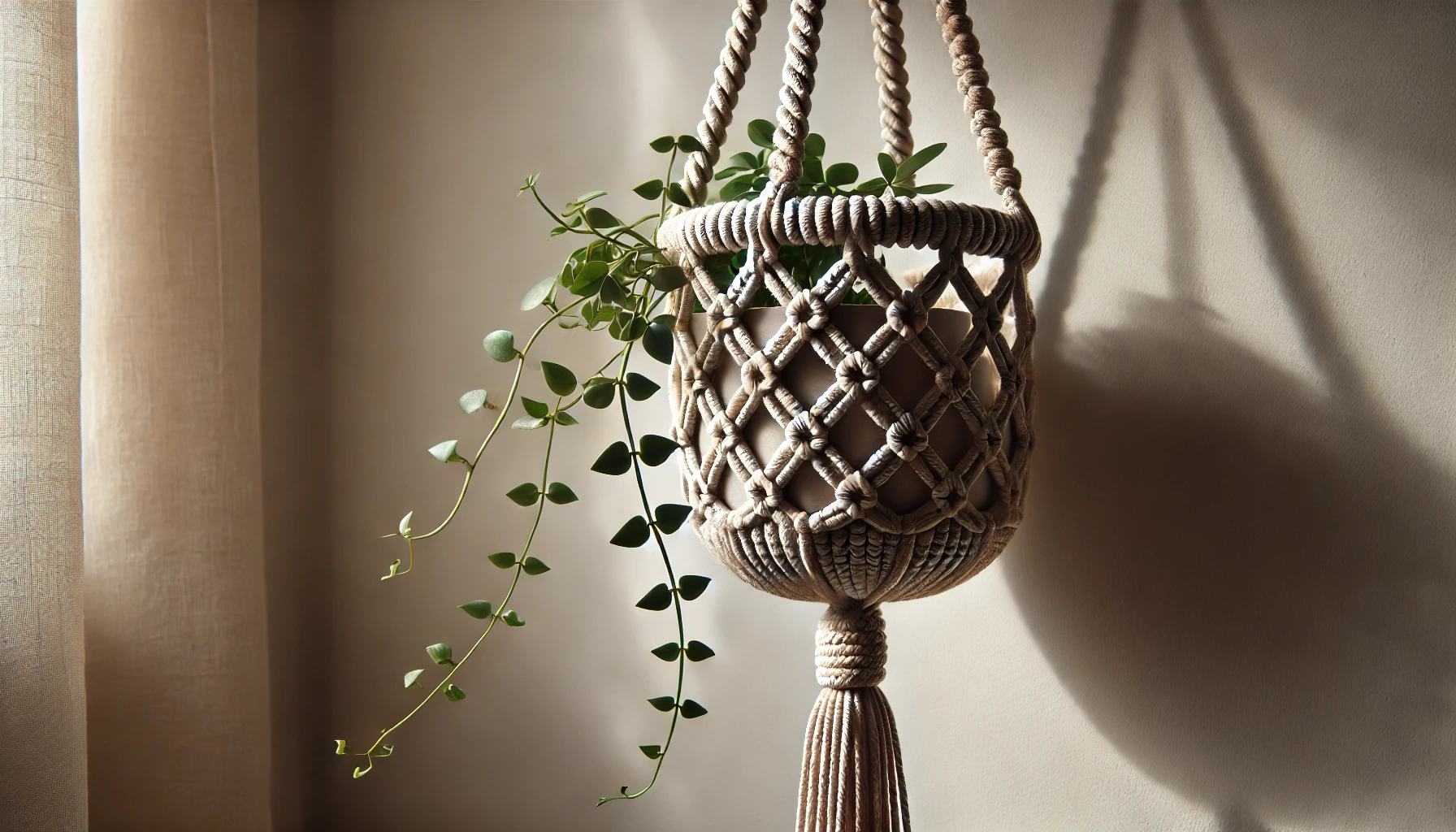
Benefits of Using Macramé Hangers for Houseplants 🌿💚
Space-Saving Magic ✨
Macramé hangers are perfect for small spaces! By hanging your plants, you free up valuable surface areas on shelves and countertops. This creates more room for other decor or practical items while still giving your plants the attention they deserve. 🌱
Improved Air Circulation 💨
Hanging plants promote better airflow around them, which is crucial for plant health. More air circulation can reduce the risk of mold and mildew, ensuring your greenery stays fresh and vibrant. 🌬️
A Stylish, Boho Vibe 🌸
Macramé hangers bring a cozy, bohemian touch to your space. Whether you’re going for a relaxed vibe or want a unique accent piece, these hangers help bring an earthy, artistic look to any room. 🌿
Great for Room Decor 🏡
Using macramé hangers elevates your home decor. The intricate knots and flowing designs create a sense of movement and dimension, giving your space an organic feel. These hangers transform your plants into living art! 🎨
Perfect for Tight Spaces 🏠
If you’re living in an apartment or smaller room, macramé hangers are a game-changer. They allow you to incorporate plants without crowding the space, adding a touch of nature even in the tiniest corners. 🌼
Keeping Plants Safe 🚫
With macramé hangers, plants are safely out of reach from pets and children. You won’t have to worry about curious paws or hands messing with your delicate greenery! 🐾
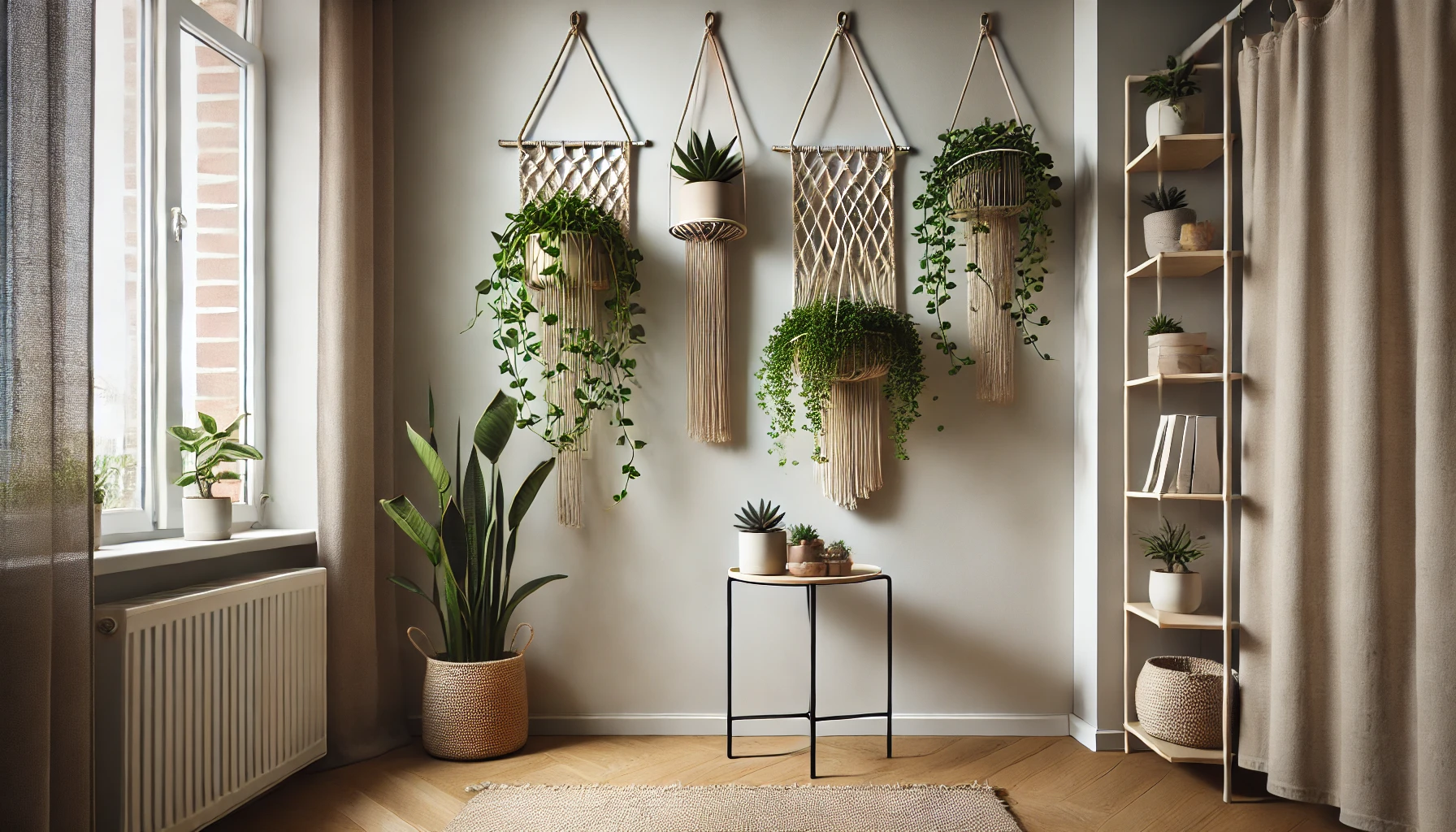
Overall, using macramé hangers for houseplants not only enhances your home’s aesthetic but also helps your plants thrive! 🌿
Choosing the Right Macramé Hanger for Your Plants 🌱💫
When selecting a macramé hanger for your plants, it’s important to consider a few key factors to ensure a perfect match. Here’s what to keep in mind:
Size and Weight of Your Plant 🌿
Choose a macramé hanger that can support the weight and size of your plant. Larger plants like ferns or ivy may need a sturdier hanger with reinforced knots, while smaller plants such as succulents or air plants will do well with lighter, simpler designs. Make sure the hanger’s capacity is strong enough to hold your plant securely. 🪴
Length of the Hanger 📏
Consider the height of your room and where you plan to hang your plant. For example, hanging your plant near a window for sunlight requires a longer hanger to reach the perfect spot, while a shorter hanger works best in smaller rooms or when placed on higher ceilings. The ideal length will let your plants hang comfortably without touching the floor. ✨
Material Matters 🌾
Macramé hangers come in various materials, with cotton, hemp, and jute being the most common. Cotton is soft, easy to work with, and adds a cozy, natural vibe. Jute, a stiffer material, gives a more rustic or earthy look. Choose a material that complements your home decor and matches the vibe you’re aiming for. 🌸
Style & Design 🎨
Macramé hangers are available in various designs, from simple, minimalist styles to more elaborate, boho-inspired patterns with beads or tassels. Choose one that matches your personal style and fits seamlessly into your home. For a clean look, go for a simple design; for a bold statement, opt for more intricate knotting patterns. 💖
Adjustable Features 🔧
Some macramé hangers come with adjustable knots, allowing you to modify the length as needed. This flexibility can be useful if you plan to change the location or height of your plants over time.
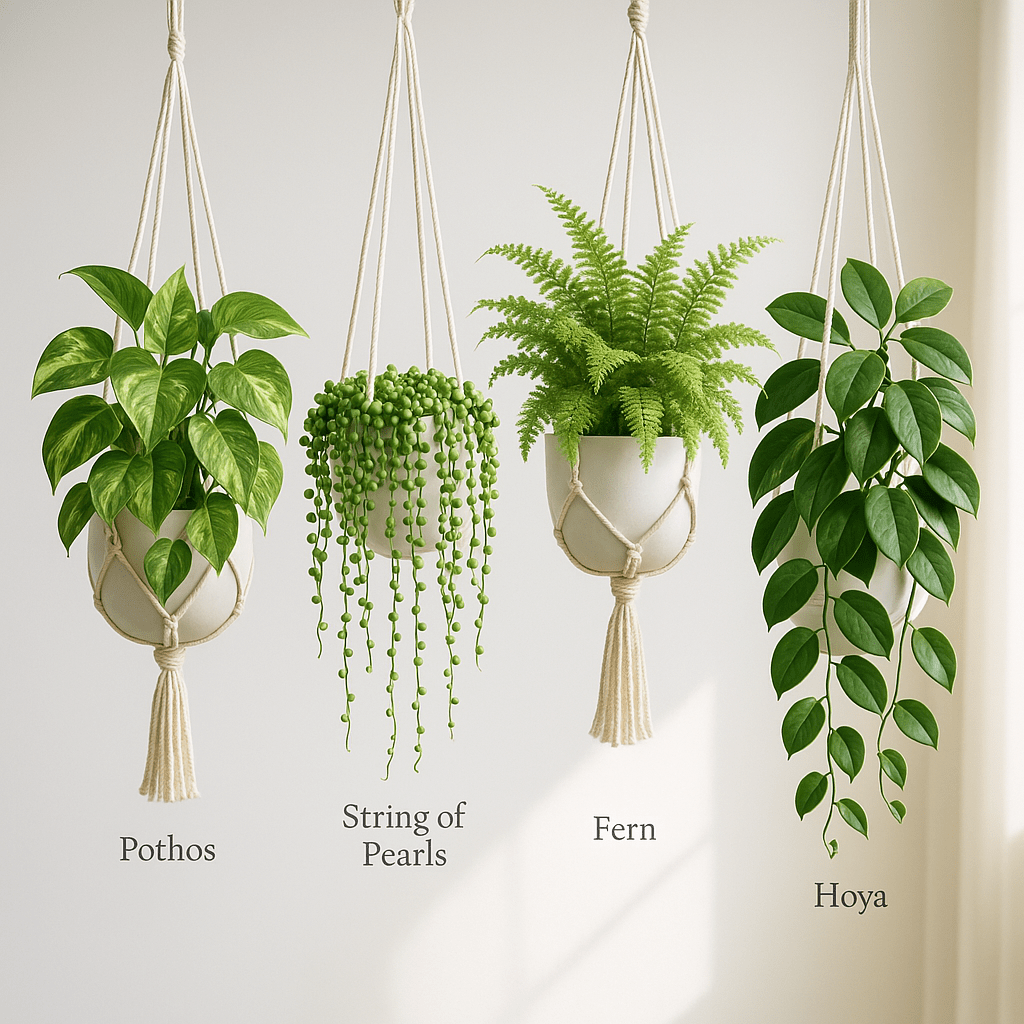
By considering these factors, you’ll choose a macramé hanger that not only fits your plant perfectly but also enhances your space with style! 🌿
How to Hang Macramé Hangers Safely 🔨🪴
Hanging your plants with macramé hangers adds charm to your space, but it’s important to ensure they’re securely installed for both safety and the health of your plants. Here’s how to hang your macramé hangers safely:
Choose the Right Location 🏡
Pick a spot that offers plenty of sunlight for your plant’s needs. However, avoid placing it where it might get knocked over or be in the way. Ensure that the space has enough headroom, especially if you’re hanging larger plants. Also, check that the area is free from drafts or moisture that could affect plant health. 🌞
Use Strong, Secure Anchor Points ⚒️
When installing macramé hangers, use sturdy ceiling hooks or wall anchors that can support the weight of your plant. Make sure the anchor points are designed to hold the weight, as some hooks may not be strong enough for larger plants. For ceiling installations, ensure you’re anchoring into a joist or a solid structure—not just drywall. 🔩
Install Hooks Properly 🔧
If you’re using ceiling hooks, ensure they’re installed correctly. Use a drill to create a hole, then screw in a heavy-duty hook. For extra security, consider using wall anchors if you’re hanging your macramé hanger from a wall. If unsure, use a stud finder to locate solid points in your ceiling or walls for maximum support. 🏗️
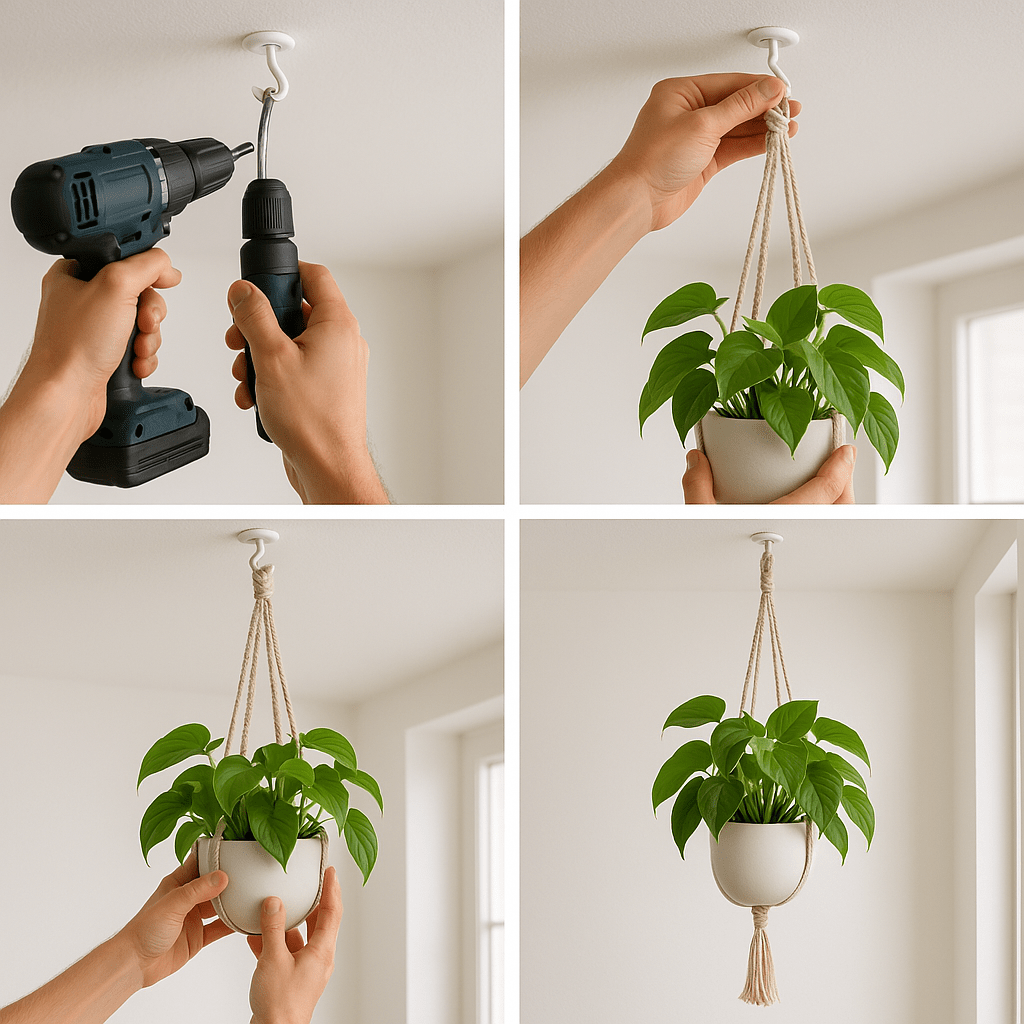
Check Weight Capacity ⚖️
Make sure your macramé hanger and the hook can hold the combined weight of your plant and pot. Larger plants will require a more robust hook, while smaller plants may only need lightweight hooks. Always check the weight specifications to avoid accidents! 🪴
Test Before Fully Setting Up ✅
Before fully hanging your plant, gently pull down on the hanger to test its stability. Ensure everything feels secure and there’s no wobbling. This step helps avoid any surprises once your plant is in place. 🧐
Keep It Balanced ⚖️
Once your macramé hanger is in place, make sure the plant is hanging evenly. Adjust the knots or ties to ensure the hanger doesn’t lean to one side, which could cause an imbalance. A balanced hanger will ensure your plant is both safe and stylish! 🌸
By following these steps, you’ll be able to enjoy the beauty of your hanging plants without any worries about safety or stability. 🌿
Best Houseplants for Macramé Hangers 🌿🪴
Macramé hangers are perfect for displaying a variety of houseplants, especially those that thrive in hanging arrangements. Here are some of the best plants to hang in macramé hangers:
Pothos (Epipremnum aureum) 🌱
Pothos is one of the easiest plants to grow and is a favorite for macramé hangers. Its long, trailing vines make it ideal for hanging, and it thrives in low to medium light. Plus, it’s low-maintenance—perfect for beginners! 🌿
Spider Plant (Chlorophytum comosum) 🕸️
Known for its air-purifying qualities, the spider plant is another excellent choice for macramé hangers. Its arching leaves and baby plantlets that dangle down make it a beautiful addition to any room. Spider plants do well in bright, indirect light. ✨
String of Pearls (Senecio rowleyanus) 🍇
This unique plant with pearl-like leaves is perfect for hanging. It grows long, trailing vines that look gorgeous in a macramé hanger. It thrives in bright light and needs minimal watering, making it a great option for busy plant owners. 🌞
English Ivy (Hedera helix) 🍃
English ivy is a fast-growing vine that looks stunning when hung in a macramé hanger. It’s ideal for creating a lush, cascading look and does well in bright, indirect light. Regular pruning helps control its growth, ensuring it doesn’t get too unruly. 🌿
Ferns (Nephrolepis exaltata) 🌿
Ferns, especially Boston ferns, love the humidity and bright, indirect light that macramé hangers provide. Their delicate fronds will cascade beautifully from the hanger, adding a touch of greenery to your space. Just be mindful of their need for regular watering! 💦
Air Plants (Tillandsia) 💨
Air plants are a fantastic option for macramé hangers because they don’t require soil to thrive. They simply need light, air, and occasional misting. Their unique shape and low-maintenance needs make them a trendy, minimalistic choice for hanging. 🌬️
Trailing Succulents 🌵
Succulents like the trailing jade or burro’s tail are perfect for hanging in macramé hangers. They offer a unique look with their plump, colorful leaves and do well in bright light. Just be sure to avoid overwatering, as succulents are drought-tolerant plants. 🌞
ZZ Plant (Zamioculcas zamiifolia) 🌿
If you’re looking for something more substantial, the ZZ plant is a great option. It’s low-light tolerant and has thick, waxy leaves that add texture to your decor. A macramé hanger will allow it to grow vertically while keeping it safe from pets. 🐾
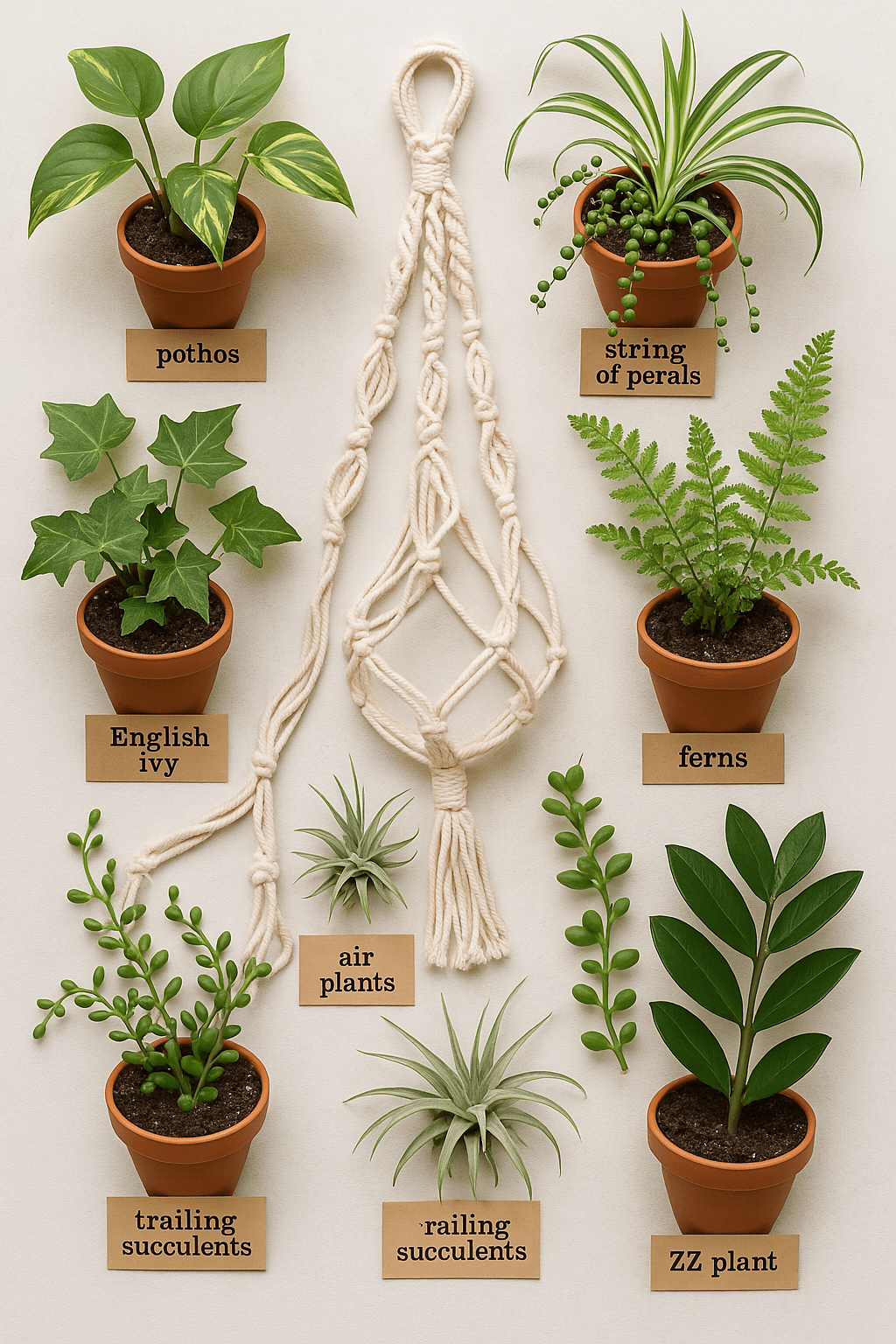
By choosing the right plant for your macramé hanger, you can create stunning displays that suit your style and fit the care requirements of each plant. 🌿✨
How to Care for Plants in Macramé Hangers 🌱💚
Taking care of plants in macramé hangers involves a few simple yet important steps to keep your greenery thriving. Here’s how to give your hanging plants the best care:
Watering Your Hanging Plants 💦
Watering can be a bit tricky with hanging plants, but it’s essential to do it carefully. Avoid overwatering, as water can accumulate in the pot and cause root rot. When watering, make sure to let the water drain properly. You can either remove the plant from the hanger or use a saucer to catch any excess water. If the plant is lightweight enough, gently tilt it for even watering. 🪴
Light Requirements 🌞
Ensure your plants are receiving the right amount of light for their needs. Most hanging plants do best in bright, indirect light, but it’s always good to double-check the light preferences of your specific plant. If your plant is not getting enough light, it might become leggy or stop growing. Consider moving the hanger to a brighter spot or rotating the plant occasionally to ensure even growth. 🌿
Rotation for Even Growth 🔄
Plants in macramé hangers can sometimes grow unevenly because they’re hanging. Rotate your plants every few weeks so all sides get equal exposure to light. This will encourage balanced growth and prevent the plant from leaning too much to one side. 🌀
Dusting and Cleaning 🧽
Macramé hangers and the plants themselves can collect dust over time. Gently wipe down the leaves of your plants with a damp cloth to keep them clean. For the hanger, use a soft brush or cloth to remove dust. If your macramé hanger starts to look dirty, you can hand wash it in cold water or spot clean it to maintain its appearance. 🌸
Check for Pests 🐛
Since hanging plants are often out of reach, pests can sometimes go unnoticed. Regularly inspect your plants for signs of pests like spider mites or aphids. If you notice any, treat your plants with organic pest control or wipe down the leaves with a mild soap solution. 🌱
Pruning and Trimming ✂️
To keep your hanging plants looking neat and healthy, regularly prune or trim any dead or yellowing leaves. For trailing plants, you can also trim the vines to encourage fuller, more bushy growth. Don’t be afraid to cut back overgrown vines—it’ll help your plant thrive and look more beautiful! 🌿

By following these simple steps, your plants will flourish in their macramé hangers and add a lovely touch to your home. 🌸
Styling Tips for Macramé Hangers ✨🌿
Macramé hangers can add a unique, boho flair to any room. Here are some creative styling tips to help you make the most of your hanging plants and elevate your home decor:
Create a Plant Gallery 🖼️
Group several macramé hangers together to form a mini indoor garden. Hang plants at varying heights to create a layered effect. Choose a mix of plants with different textures, like trailing vines, ferns, and succulents, to create visual interest. This works great in corners, near windows, or as a statement piece in your living room. 🌸
Mix and Match Styles 🎨
Macramé hangers come in different patterns, from simple knots to more intricate designs with beads and tassels. Feel free to mix and match different styles and materials to add depth to your decor. For a modern touch, pair minimalist hangers with lush green plants. For a more boho vibe, opt for intricate designs with colorful accents. 🌞
Play with Pot Colors and Materials 🎨
The pot you choose can complement or contrast the macramé hanger. For a natural, earthy look, pair light-colored ceramic pots or terra cotta with neutral macramé hangers. For a pop of color, choose bold, brightly colored pots or metallic finishes that stand out against the macramé knots. 🌺
Use Macramé to Frame Windows 🌅
Hang macramé hangers near windows to frame the view with greenery. This creates a calming, natural border and brings the outdoors in. It’s a perfect way to showcase your plants while allowing them to thrive in natural light. 🌞
Make a Vertical Garden 🌿
If you have limited floor space, use macramé hangers to create a vertical garden. Hang plants from different levels on a wall or from a ceiling hook, turning your wall into a living, breathing piece of art. Use a mix of larger plants at the bottom and smaller ones at the top for a cascading effect. 🪴
Create a Cozy Reading Nook 📚
Hanging plants in macramé hangers can transform a small corner into a cozy, relaxing space. Add a comfy chair, some throw pillows, and a soft blanket, and surround the area with hanging greenery to create a peaceful, nature-filled retreat. 🌿
Pair with Other Boho Decor 🌸
Macramé hangers fit beautifully with bohemian-style decor. Pair them with macramé wall hangings, woven baskets, or vintage rugs to enhance the earthy, free-spirited vibe. Add in a few candles or fairy lights for a magical, cozy atmosphere. ✨

With these styling tips, you can use macramé hangers to showcase your plants in a way that enhances your space and suits your personal style! 🌿
DIY: How to Make Your Own Macramé Hanger 🪡🌿
Making your own macramé hanger is a fun and creative project that allows you to customize your plant display exactly how you want it. Here’s a simple step-by-step guide to get you started:
Materials You’ll Need:
- Macramé cord (around 3mm thickness works best)
- A wooden ring (for the top of the hanger, or a sturdy metal hook if you prefer)
- Scissors ✂️
- A measuring tape 📏
- Your plant pot (to determine the length of the hanger)
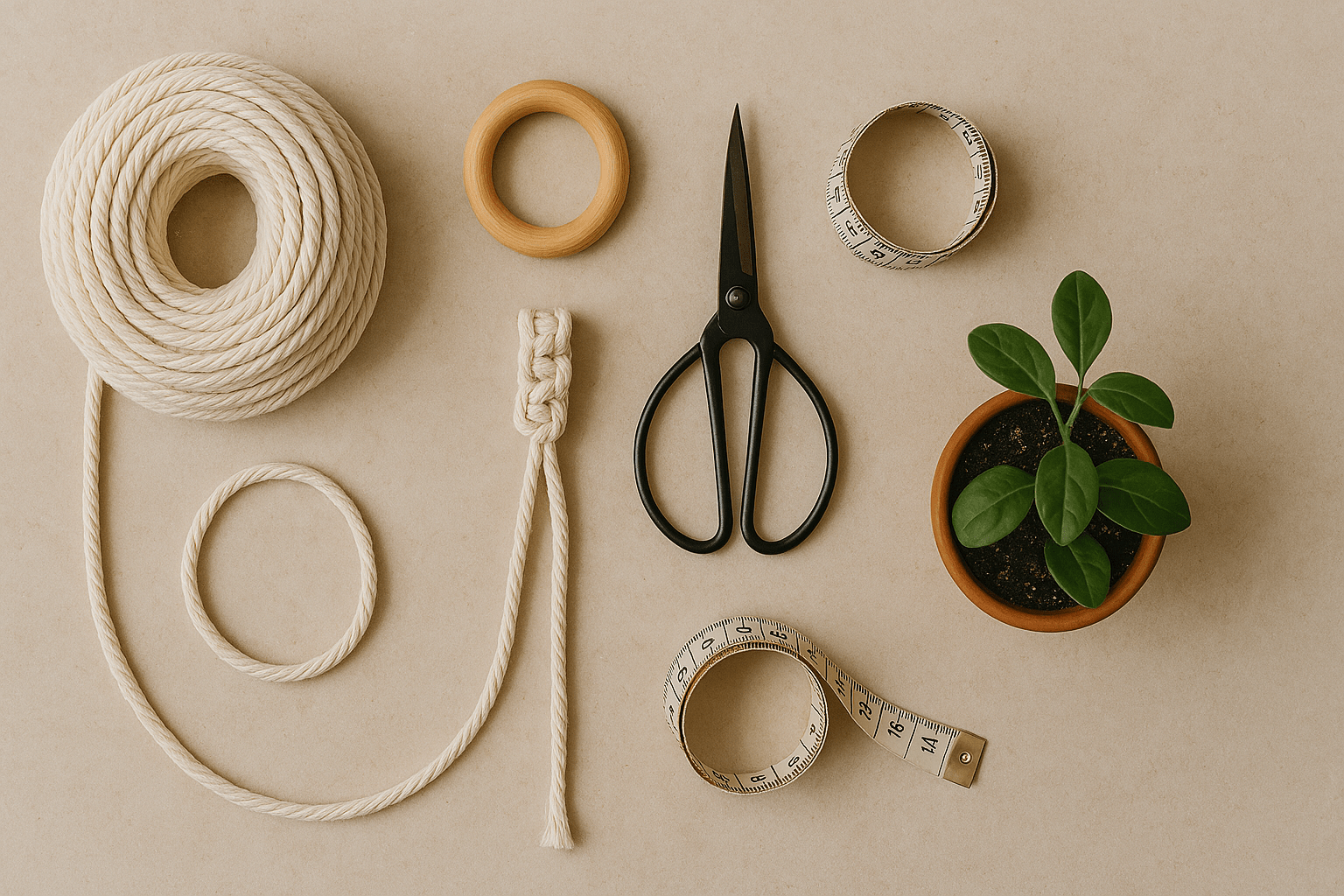
Step-by-Step Instructions:
Measure and Cut Your Cord 📏
Cut four equal lengths of macramé cord, each about 2-3 feet long, depending on how long you want your hanger to be. You can always trim the excess later. These cords will form the main structure of your hanger.
Secure the Cords to the Ring 🔗
Fold each piece of cord in half and secure it to the wooden ring by creating a Lark’s Head Knot. Simply fold the cord over the ring, pass the ends through the loop, and pull it tight. This will attach all four cords to the ring.
Create the First Knot: Square Knots 🪡
Now, divide the cords into two groups of two. For the first knot, use the left cord as the anchor and bring the right cord over it to form a “4” shape. Then, pass the right cord under both the anchor cords and pull it through the loop. Repeat the process a few times, creating square knots that form a beautiful texture. Do this for the entire group of cords.
Add Extra Rows of Knots (Optional) ✂️
For a more intricate look, add a few more rows of square knots, leaving about 2-3 inches between each row. The more rows you add, the longer and more detailed your hanger will be!
Divide the Cords for the Pot Holders 🪴
Once you have a few rows of square knots, you’ll reach the part where your plant pot will sit. To form the pot holder, separate the cords into four equal sections, one for each corner of your pot. These will hold the pot in place.
Create the Base Knots 🔄
To create the base of the hanger, you can use either square knots or a simple knot pattern, depending on how intricate you want the design to be. Leave a bit of space between the knots so that your plant pot will rest comfortably within the hanger.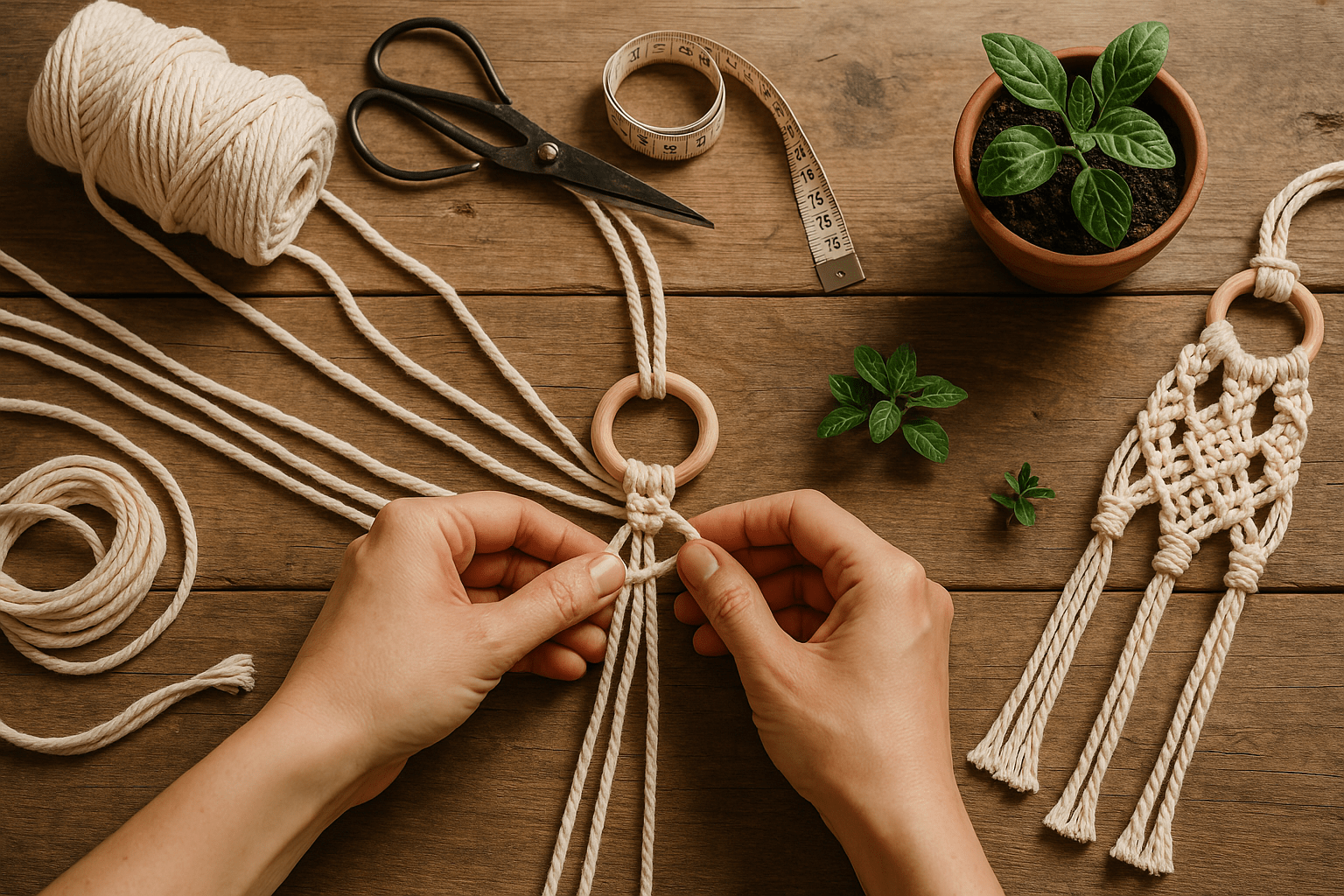
Trim and Finish ✂️
Once the base is complete, trim the cords to your desired length, creating an even fringe at the bottom. You can leave them long and flowing or trim them for a more polished look. Tie the ends of the cords together with a knot to secure the fringe.
Hang and Display Your Plant 🌿
Now that your macramé hanger is complete, simply hang it from the ring or hook, and place your plant pot inside! Make sure the hanger is secure and balanced, and your new DIY plant hanger is ready to show off your greenery in style.
Tips:
- Experiment with different knot patterns, like the half knot or spiral knot, to create a unique look.
- Use colored macramé cord or add decorative beads for a personalized touch.
- For larger plants, use thicker cord or additional cords to ensure stability.
With just a few simple steps, you can create a macramé hanger that adds a personal, handmade touch to your home decor! 🌸
Common Mistakes to Avoid with Macramé Hangers 🚫🪴
While macramé hangers can be a beautiful addition to your home, it’s easy to make a few mistakes during installation and care. Here are some common missteps to watch out for and how to avoid them:
Choosing the Wrong Size Hanger for Your Plant Pot 🏺
One of the most common mistakes is using a macramé hanger that’s too small or too large for your plant pot. A small hanger may cause the pot to fall out, while a large one can make your plant look unbalanced. Always measure your pot and ensure the hanger can comfortably hold it. Make sure there’s enough room for the pot to rest securely at the base. 🌿
Not Using the Right Anchor Point 🔩
Hanging plants in macramé hangers requires strong and stable anchor points. Hanging them from weak hooks or unsupported areas (like drywall) can cause the pot to fall. Always install your hanger into a ceiling joist, beam, or use a sturdy wall anchor that can bear the weight of the plant and the pot. 💪
Overwatering Hanging Plants 💦
It’s easy to overwater hanging plants because the pot may drain slowly when it’s elevated. Ensure that the plant pot has drainage holes, and consider placing a saucer or tray beneath the plant to catch excess water. Avoid letting water pool in the macramé hanger, as this can cause root rot. 💧
Forgetting to Rotate Plants for Even Growth 🔄
Plants hanging in macramé hangers tend to grow unevenly due to their position. Neglecting to rotate the plant can cause it to become lopsided or lean toward the light source. Rotate your plants regularly to ensure they grow evenly and stay healthy. 🌱
Using Incompatible Plants 🪴
Not all plants are suitable for macramé hangers. Avoid placing heavy or high-maintenance plants in a hanging arrangement, as they may require more care than macramé hangers can provide. Opt for plants that are easy to care for and lightweight, like pothos, spider plants, or succulents. 🌺
Not Considering Light Needs 🌞
Hanging plants are often placed near windows, but it’s important to remember their specific light requirements. Some plants, like succulents, need direct sunlight, while others, like ferns, thrive in low light. Ensure that your plant is placed in a location where it gets the light it needs, or you could risk stunted growth. 🌞
Ignoring Plant Maintenance 🧽
Plants in macramé hangers can collect dust and debris, making it harder to spot pests or damage. Regularly clean your plants’ leaves and check for any signs of pests or disease. Keep the macramé hanger tidy as well by wiping off dust with a damp cloth. ✂️
Hanging Too High or Too Low 📏
Hanging your plants too high or too low can make it difficult to water them or even cause a safety hazard. Make sure your plants are at a comfortable height for both maintenance and aesthetic purposes. Ideally, the plants should be easily accessible to water, rotate, and clean. 🪴
Not Checking for Stability 🔎
Before fully setting your plants in place, always double-check the stability of the hanger. Gently pull on it to make sure it’s securely fastened and that the macramé knots are strong enough to support the weight. It’s better to be safe than sorry when it comes to plant safety! 🏠

By avoiding these common mistakes, you’ll be able to make the most of your macramé hangers and keep your plants happy, healthy, and stylish! 🌿✨
Final Thought
Using macramé hangers for houseplants is not only a stylish way to showcase your greenery but also a practical solution to save space and add a unique touch to your home decor. From enhancing the aesthetic of any room to giving your plants the perfect environment to thrive, macramé hangers are a wonderful choice for plant lovers of all levels.
By choosing the right hanger, ensuring proper care, and styling your plants creatively, you can enjoy the beauty of hanging greenery in a way that suits your space and personal style. Remember to avoid common mistakes, like overwatering and improper lighting, to keep your plants flourishing in their macramé hangers.
Whether you’re a DIY enthusiast or simply looking for a trendy way to display your plants, macramé hangers offer endless possibilities to make your home feel vibrant, cozy, and full of life. Happy hanging! 🪴✨
Frequently Asked Questions (FAQ)
Why use macramé hangers for houseplants?
They offer a decorative and space-saving way to showcase plants while adding texture and charm to your home décor.
What types of plants work well in macramé hangers?
Trailing plants like pothos, ivy, spider plants, and string of pearls look especially beautiful when hung in macramé.
Are macramé hangers suitable for all pot sizes?
They come in various sizes and can be adjusted to fit small to medium pots. Always check the weight capacity before hanging.
Where should I hang macramé planters indoors?
Place them near windows with good natural light, or from ceiling hooks in corners, in front of windows, or over furniture.
Can I make my own macramé plant hanger?
Yes, macramé is a beginner-friendly craft. You’ll need cotton cord, a ring, and some basic knotting techniques.
Do macramé hangers work with all décor styles?
While perfect for boho and eclectic interiors, neutral-toned hangers can blend into minimalist, rustic, or modern styles too.
How do I water plants in macramé hangers without mess?
Remove the pot to water in the sink, or use a pot with drainage inside a decorative outer pot that catches excess water.
Are there outdoor macramé hanger options?
Yes, but choose weather-resistant materials if hanging outdoors, as natural cotton can wear quickly in wet conditions.
